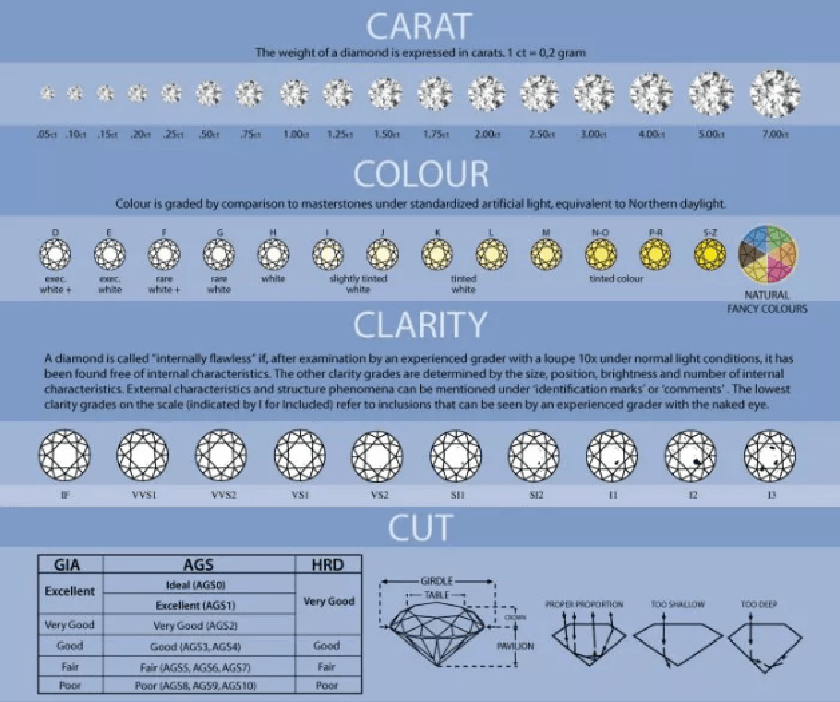The History of Diamond Engagement Rings:
Presenting a diamond engagement ring started in the late 15th century when Archduke Maximilian of Austria gave it to Mary of Burgundy upon their engagement. However, it wasn't until the In the 1940s, the De Beers company launched a highly successful marketing campaign with the phrase "A Diamond is Forever." This solidified the diamond's association with eternal love and established the diamond engagement ring as a cultural norm.
Cultural Significance:
Diamond engagement rings have become synonymous with commitment and the beginning of a lifelong journey. The sparkle of a diamond represents the enduring nature of love, while the circular shape symbolizes eternity and the unending commitment between partners. Across different cultures, exchanging engagement rings has become a universal gesture of love and devotion.
Fact: The 4 C's of Diamonds
When purchasing a diamond engagement ring, understanding the Four C's—cut, color, clarity, and carat—is crucial. The cut refers to how well the diamond reflects light, the color scale ranges from colorless to light yellow, clarity measures the presence of internal flaws, and the carat represents the weight of the diamond. These factors collectively determine the quality and value of the diamond.
 <2>Fiction: The Bigger, the Better
<2>Fiction: The Bigger, the Better
While a larger diamond may seem like the epitome of luxury, size is not the only factor contributing to a diamond's beauty. The cut and quality are equally important, if not more so. Well- cut gems with excellent clarity and color can outshine a larger stone with inferior qualities. It's essential to balance size and quality when selecting an engagement ring.

Ethical Considerations:
In recent years, ethical concerns have come to the forefront of the diamond industry. The Kimberley Process Certification Scheme refers to mined diamonds in war zones sold to finance armed conflict against governments. However, concerns about the effectiveness of the process and its loopholes persist.
Fact: Ethical Alternatives
In response to ethical concerns, many couples opt for alternative options such as lab-grown diamonds or other gemstones. C.V.D (Lab-Grown Diamond) diamonds are created in a controlled environment, eliminating the ethical issues associated with traditional mining. Additionally, choosing other gemstones can add a unique and personal touch to the engagement ring while avoiding the ethical dilemmas tied to diamonds.
Fiction: The Inflation of Prices
One common misconception is that diamond prices are determined by their rarity and quality. In reality, the diamond market is influenced by marketing, brand perception, and industry monopolies. De Beers, for instance, has historically controlled a significant portion of the diamond market, allowing them to regulate prices. As a result, the perception of diamonds as rare and precious has contributed to their high market value.
Environmental Impact:
Mining diamonds have been associated with environmental degradation, including deforestation, habitat destruction, and soil erosion. Traditional mining practices can have long-lasting effects on ecosystems and local communities.
Fact: Sustainable Practices
The diamond industry is gradually adopting more sustainable practices in response to environmental concerns. Implementing eco-friendly mining techniques, reforestation initiatives, and community development programs aims to minimize the environmental impact of diamond mining. Consumers increasingly seek responsibly sourced diamonds and supporting companies committed to ethical and sustainable practices.
Fiction: The Indestructible Nature of Diamonds
While diamonds are known for their hardness, they are not indestructible. Diamonds can chip or fracture under extreme pressure, and harsh chemicals can damage them. Proper maintenance is essential to preserving the beauty and longevity of a diamond engagement ring. Regular cleaning and professional inspections can help ensure the ring remains a cherished symbol of love for generations.
Conclusion:
Diamond engagement rings have evolved from a symbol of aristocracy to a cultural phenomenon that transcends borders. The history, cultural significance, and ethical considerations surrounding these precious gems are as complex and multifaceted as the stones themselves. As couples choose an engagement ring, understanding the facts and dispelling the fiction can empower them to make informed decisions that align with their values and beliefs. Whether opting for a traditional diamond or exploring alternative options, the true meaning of a diamond engagement ring lies in the commitment and love it represents.


























Validate your login